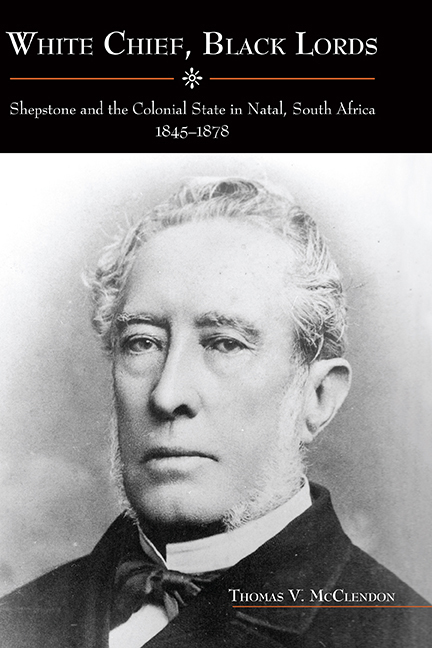Book contents
- Frontmatter
- Dedication
- Contents
- List of Illustrations
- Acknowledgments
- List of Abbreviations
- 1 Introduction
- 2 The Man Who Would Be Inkosi
- 3 Witchcraft and Statecraft
- 4 You Are What You Eat Up
- 5 Guns, Rain, and Law
- 6 From Show Trial to Shallow Reform
- 7 Conclusion
- Notes
- Glossary
- Bibliography
- Index
- Rochester Studies in African History and the Diaspora
- Frontmatter
- Dedication
- Contents
- List of Illustrations
- Acknowledgments
- List of Abbreviations
- 1 Introduction
- 2 The Man Who Would Be Inkosi
- 3 Witchcraft and Statecraft
- 4 You Are What You Eat Up
- 5 Guns, Rain, and Law
- 6 From Show Trial to Shallow Reform
- 7 Conclusion
- Notes
- Glossary
- Bibliography
- Index
- Rochester Studies in African History and the Diaspora
Summary
The colonial official … discovered that indirect rule joined together what the civilizing mission put asunder.
Karen Fields, Revival and Rebellion in Colonial Central AfricaIn 1855, colonial Natal's native administration, led by Secretary of Native Affairs (SNA) Theophilus Shepstone, became embroiled in a witchcraft dispute that exposed the contingencies and contradictions of the colonial civilizing mission. Colonial contingencies, especially those involving fiscal limitations, constrained the civilizing mission and forced the colonial state to participate in African discourses of power, ruling through indigenous leaders while attempting to constrain their authority and relying on indigenous norms while attempting to reshape them. A state that purported to civilize, based on European standards, necessarily depended on the active and willing participation of African indigenous leaders—so-called chiefs—and the recognition of “uncivilized” African customs in a colonial legal system. The 1855 conflict pitted an inkosi (lord; conventionally translated as chief) against three of his subjects, whom he accused of plotting to kill him through ubuthakathi (evildoing; conventionally translated as witchcraft). While the colonial state purported to rule through indigenous laws and customs, it reserved the right to declare some practices, such as “pretended witchcraft,” out of bounds as repugnant to allegedly universal civilized norms. When the accused abathakathi (evildoers; witches) took refuge at a nearby mission station, Shepstone found himself locked in a multisided standoff over power and authority with the chief, the accused witches, the local magistrate, and the missionary and mission residents. He attempted to resolve the dispute by persuading the purported abathakathi to leave the mission station and go to a place where the inkosi would no longer feel threatened by their presence. This proposal led the missionary to accuse colonial officials of sanctioning belief in witchcraft, as the plan to encourage the men to accept voluntary exile was said to reinforce the belief of the inkosi and his loyal followers that the accused men were capable of threatening him through sorcery. The matter was still unresolved several months later when the inkosi died, confirming for many the suspicion that he had been the victim of ubuthakathi and that the government had enabled the abathakathi to do their evil work.
- Type
- Chapter
- Information
- White Chief, Black LordsShepstone and the Colonial State in Natal, South Africa, 1845–1878, pp. 1 - 20Publisher: Boydell & BrewerPrint publication year: 2010



